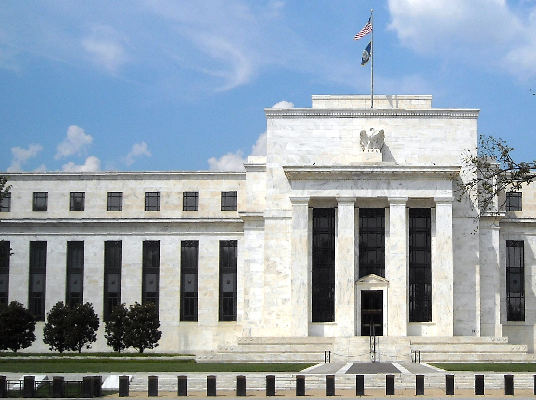(Kitco News) – Gold prices remain under pressure, as the Federal Reserve further reduces the level of bonds it purchases every month and continues to signal three rate hike next year.
Following its monetary policy meeting, the Federal Reserve as expected left interest rates unchanged at the zero-bound range; however, the central bank continues to adjust its monetary policy as it acknowledges growing inflation pressures.
“In light of inflation developments and the further improvement in the labor market, the Committee decided to reduce the monthly pace of its net asset purchases by $20 billion for Treasury securities and $10 billion for agency mortgage-backed securities. Beginning in January, the Committee will increase its holdings of Treasury securities by at least $40 billion per month and of agency mortgage-backed securities by at least $20 billion per month. The Committee judges that similar reductions in the pace of net asset purchases will likely be appropriate each month, but it is prepared to adjust the pace of purchases if warranted by changes in the economic outlook,” the monetary policy statement said.
The gold market continues to struggle as the Federal Reserve moves closer to pivoting on interest rates. February gold futures last traded at $1,759.80, down 0.63% on the day.
According to some market analysts, gold investors are focusing on the Federal Reserve’s interest rate projections, also known as the dot plots, which have jumped from September’s forecast. The committee sees the Fed funds rate at 0.9% next year, indicating at least three rate hikes, up sharply from September’s forecast for interest rates at 0.3%.
The U.S. central bank also sees interest rates moving to 1.6% in 2023 and rising to 2.1% by 2024, up from the previous forecasts of 1.0% and 1.8% respectively.
The Federal Reserve sees slightly slower growth prospects in the next few years as the economy continues to recover from the COVID-19 pandemic. Federal Reserve sees the U.S. gross domestic product growing 5.5% this year, down from 5.9% forecasted in September. Economic growth next year has been revised higher to 4.0%, up from the previous projection of 3.8%. The economy is expected to grow 2.2% in 2023, up down from September’s estimate of 2.5%. The economy is expected to grow 2.0% in 2024, unchanged from the previous forecast.
While the Fed continues to see positive economic growth it did highlight that the COVID-19 pandemic remains a concern.
“The path of the economy continues to depend on the course of the virus. Progress on vaccinations and an easing of supply constraints are expected to support continued gains in economic activity and employment as well as a reduction in inflation. Risks to the economic outlook remain, including from new variants of the virus,” the central bank said in its monetary policy statement.
The U.S. central bank sees a slightly stronger labor market in the next two years. For 2021 the unemployment rate is expected to fall to 4.3%, compared to September’s forecast of 4.8%. For next year, the unemployment rate is expected to be 3.5%, down from previous forecast of 3.5%. The unemployment rate is expected to hold steady at 3.5% through 2024, unchanged from the previous projections.
While the Federal Reserve has acknowledged that inflation has proved to be stickier than expected, the committee doesn’t expect it to be a major issue after this year.
The projections show that the Personal Consumption Expenditures Index (PCE) is expected to rise 5.3% in 2021, up from September’s estimate of 4.2%. However, inflation pressures are expected to level off in 2022, rising 2.6%, up from September’s estimate of 2.2%. In 2023, the Federal Reserve expects inflation to rise to 2.3%, up from the previous estimate of 2.2%. By 2024 consumer prices pressure are expected to rise to 2.1%.
Core inflation expectations, which strip out volatile food and energy prices, are expected to rise 4.4% this year, up compared to the previous estimate of 3.7%. Next year, core inflation is expected to rose 2.7%, compared to September’s forecast of 2.3%. In 2023, inflation is expected to rise to 2.3%, up from the previous estimate of 2.2%. Inflation is expected to moderate to 2.1% in 2024.
Michael Pearce, senior U.S. economist at Capital Economics, said that the Federal Reserve appears to be slightly more hawkish than expected; The U.K-based research firm noted that it sees three rate hikes next year but Pearce added that it is unlikely that the central bank will raise interest rates before June.
“Overall, the Fed has effectively abandoned its average inflation targeting framework and is moving fast to get policy back to a more neutral setting, which reduces the risks that inflation remains meaningfully above 2% over the longer term,” he said.
Disclaimer: The views expressed in this article are those of the author and may not reflect those of Kitco Metals Inc. The author has made every effort to ensure accuracy of information provided; however, neither Kitco Metals Inc. nor the author can guarantee such accuracy. This article is strictly for informational purposes only. It is not a solicitation to make any exchange in commodities, securities or other financial instruments. Kitco Metals Inc. and the author of this article do not accept culpability for losses and/ or damages arising from the use of this publication.

